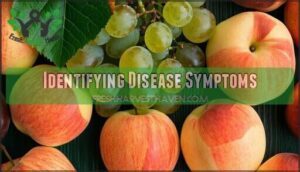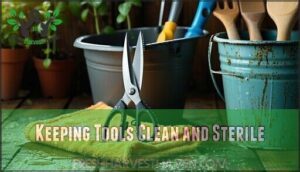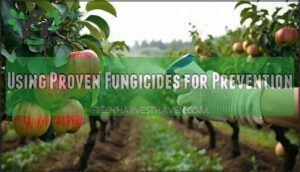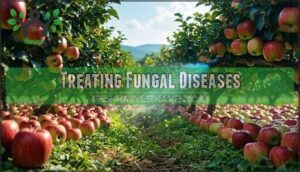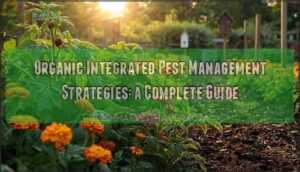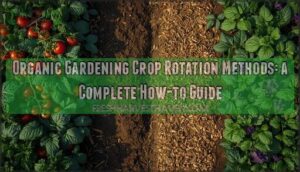This site is supported by our readers. We may earn a commission, at no cost to you, if you purchase through links.
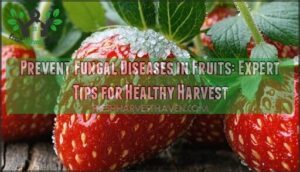
Start with disease-resistant varieties and choose planting sites with excellent air circulation.
Water at soil level early in the morning—overhead watering creates a fungal paradise.
Space plants properly to prevent overcrowding, which traps moisture and encourages disease.
Keep tools clean between uses, and avoid working in wet conditions.
When prevention isn’t enough, trusted fungicides can save your harvest.
The key is staying one step ahead of these sneaky invaders that can turn your fruit dreams into a moldy nightmare.
Table Of Contents
- Key Takeaways
- Prevent Fungal Diseases
- Fungal Disease Identification
- Disease Prevention Strategies
- Treating Fungal Diseases
- Maintaining Garden Health
- Frequently Asked Questions (FAQs)
- How do I prevent fungus from damaging my fruit trees?
- Should I treat my fruit trees with fungicide?
- Do fruit trees have fungal diseases?
- What Fungi affect fruit trees?
- What fruits are affected by a fungus?
- Can dietary choices help prevent fungal infections?
- Which fruits are anti-fungal?
- How to avoid fungus on fruits?
- How to prevent fungus on fruit trees?
- How can you prevent fungi disease?
- Conclusion
Key Takeaways
- Choose disease-resistant varieties and plant strategically – You’ll prevent most fungal problems by selecting resistant cultivars and positioning trees with proper spacing for maximum air circulation and morning sunlight exposure.
- Master your watering technique – Water at soil level during early morning hours to keep leaves dry, avoid overhead watering that creates humid conditions fungi love, and maintain consistent moisture without overwatering.
- Stay vigilant with monitoring and sanitation – You need to inspect your trees weekly for early disease symptoms, keep tools sterilized between uses, and immediately remove any infected plant material to prevent spread.
- Apply preventive fungicides when necessary – Use copper or sulfur-based fungicides during dormancy and follow proper timing intervals, rotating between different types to prevent resistance while respecting pre-harvest requirements.
Prevent Fungal Diseases
You can protect your fruit harvest from fungal diseases by selecting resistant varieties, providing proper air circulation, and using smart watering techniques.
These preventive steps create an environment where your fruit trees thrive while harmful fungi struggle to establish themselves, allowing you to have a successful and healthy harvest.
Selecting Disease-Resistant Fruit Varieties
Through careful variety selection, you’ll build your orchard’s first line of defense against fungal diseases.
Disease-resistant varieties like Enterprise apples and Liberty cultivars offer built-in protection that reduces your reliance on chemical treatments throughout the growing season.
Choose varieties bred to resist disease—they’re your orchard’s natural armor against fungal attacks.
When choosing fruit trees, focus on variety characteristics that match your local climate conditions.
Heirloom options often lack modern disease resistance, so prioritize newer cultivars bred specifically for plant resistance.
Rootstock resistance plays an equally important role—hardy rootstocks strengthen your tree’s overall immune system against soil-borne pathogens.
Local adaptability guarantees your varieties thrive in regional weather patterns that influence disease pressure.
Genetic diversity across your orchard prevents widespread losses if one variety succumbs to infection.
- Smart selection strategy: Research university extension recommendations for your hardiness zone, comparing disease resistance ratings across multiple fungal threats like fire blight, apple scab, and powdery mildew before making final purchasing decisions.
Planting Sites for Air Circulation
Nobody wants to create a fungal paradise in their fruit garden.
Strategic planting sites focus on air circulation and optimal orientation to prevent fungal diseases.
| Factor | Best Practice |
|---|---|
| Sunlight Exposure | Position trees for maximum morning sun |
| Wind Direction | Align with prevailing winds for airflow |
| Soil Drainage | Choose elevated, well-draining locations |
Wide spacing between trees reduces humidity buildup while proper microclimate creation strengthens disease prevention.
Think of your orchard layout like designing ventilation—you’re engineering an environment where fruit fungal diseases can’t establish.
Smart positioning with consideration for wind direction and soil drainage transforms your garden into a fortress against fungal invaders.
Watering Practices for Disease Prevention
When you step into premium watering practices, you’re setting the foundation for disease-free fruits.
Smart irrigation keeps fungal invaders at bay through strategic moisture control.
Smart watering starves fungi of their favorite breeding grounds.
- Early watering guarantees leaves dry quickly before spores can establish, making morning your garden’s golden hour
- Drip irrigation delivers precise soil moisture without creating the humid leaf conditions fungi crave
- Consistent schedule with proper soil moisture monitoring prevents overwatering disasters that invite disease
Avoid overwatering by checking soil conditions regularly.
Employing efficient watering tools can substantially reduce water waste and promote healthier plant growth.
Your watering practices directly impact air circulation around plants, and when you control moisture wisely, you’re basically starving potential fungal growth of its favorite breeding grounds.
Fungal Disease Identification
Spotting fungal diseases early saves your fruit harvest from devastating crop loss.
You’ll learn to recognize common symptoms like apple scab’s olive spots, powdery mildew’s white coating, and cedar rust’s orange marks before they spread throughout your orchard.
Common Fungal Diseases in Apple Trees
Most apple fungal diseases can devastate your harvest if you don’t recognize the warning signs early.
Apple Scab appears as olive-green, velvety spots on leaves and fruit, thriving in wet conditions with temperatures between 60-75°F.
You’ll spot Cedar Rust as bright orange spots with black centers during damp spring weather.
Powdery Mildew creates a distinctive white coating on leaves during hot, dry periods, while Sooty Blotch leaves black, smudgy marks on fruit surfaces in high humidity.
Flyspeck produces tiny black dots that look like someone flicked ink on your apples.
Quick identification saves your crop from these common invaders, and following control tips can help prevent the spread of disease, ensuring a healthy harvest with minimal loss to fungal diseases.
Fungal Diseases in Other Fruits
After exploring apple tree troubles, it’s clear other fruits also face their own fungal nightmares.
Watch out for these common issues:
- Grape Fungal Diseases: Powdery mildew and black rot can leave clusters shriveled and unsellable.
- Stone Fruit Issues: Brown rot in peaches and plums turns sweet treats into mushy disappointments.
- Citrus Diseases: Citrus black spot and greasy spot cause blemishes and fruit drop, especially in humid climates.
- Berry Fungi: Strawberry fungal diseases like gray mold ruin berries before you can enjoy them.
- Tropical Fungi: Mangoes and bananas suffer from anthracnose and Black Sigatoka, slashing yields fast.
Spotting these uncommon infections early means you stay one step ahead.
Identifying Disease Symptoms
Recognizing fungal disease symptoms fruit early protects your harvest from disaster.
Watch for Leaf Spotting, Fruit Discoloration, and Unusual Growth patterns that signal trouble ahead.
Visible Mold, Stem Lesions, and wilted branches reveal active infections spreading through your trees.
Disease symptoms like white powdery coatings or black specks demand immediate attention.
Master disease identification by checking leaves, stems, and fruit surfaces weekly.
Quick fungal disease identification turns potential crop losses into successful harvests—your vigilance makes all the difference.
Disease Prevention Strategies
You can keep fungal diseases at bay by choosing healthy plants, keeping your tools clean, and using only proven fungicides.
With these practical steps, your fruit harvest won’t end up looking like a science experiment gone wrong.
Choosing Disease-Free Plants and Seeds
Your garden’s success starts with smart shopping decisions at reputable growers who prioritize quality over quick sales.
When you’re browsing nurseries, you’ll want to conduct thorough plant inspections and seed inspections before bringing anything home. Look for vibrant foliage, sturdy stems, and zero signs of spots or wilting that signal trouble ahead.
Smart variety selection involves these key steps:
- Research plant history – Ask about the source and growing conditions of your potential purchases
- Choose disease-resistant fruit trees – Select varieties bred specifically to fight common fungal problems
- Inspect disease-free plants and disease-free seeds carefully for any red flags like discoloration or soft spots
- Practice early detection – Remove questionable specimens immediately to protect your entire garden investment
This foundation work pays dividends when harvest time arrives, giving you healthy, productive plants that’ll resist fungal attacks naturally.
Keeping Tools Clean and Sterile
Your garden tools can become silent carriers of destructive fungal spores if you don’t maintain proper sanitation practices. After each use, especially when moving between different plants or garden areas, you’ll need to clean and disinfect your tools to prevent spreading diseases throughout your garden.
Start with basic cleaning solutions like warm soapy water to remove visible dirt and plant debris from blades and handles. For sterilization methods, follow up with a 10% bleach solution or 70% rubbing alcohol to kill lingering spores and pathogens.
- Store sterilized tools in a dry location to prevent moisture buildup that encourages bacterial and fungal growth on metal surfaces.
Tool sanitation becomes especially critical when pruning diseased branches or working with infected soil. Implementing proper sanitation practices can help prevent the spread of diseases. Garden hygiene practices include keeping separate tools for different garden zones and replacing worn equipment that can’t be properly cleaned. Long-term storage requires oiling metal components after cleaning to prevent rust formation.
Using Proven Fungicides for Prevention
Clean tools matter, but choosing the right fungicides takes fruit disease prevention to the next level.
Broad-spectrum fungicides like chlorothalonil protect against multiple pathogens, while systemic vs contact options offer different protection methods—systemics work inside plants, contacts shield surfaces.
Fungicide application timing is everything: apply during cool morning or evening hours before infection periods begin. Consider using specific fruit tree fungicides for ideal results.
Fungicide resistance management requires rotating between different chemical classes and mixing modes of action. Don’t let pathogens outsmart your strategy!
Follow safe handling practices by reading labels carefully, wearing protective gear, and respecting pre-harvest intervals. Proper fungicide application timing, combined with resistance management tactics, keeps your fruit trees healthy and productive season after season.
Treating Fungal Diseases
When fungal diseases strike your fruit trees, you’ll need to act quickly to prevent crop loss and protect future harvests.
The right treatment approach depends on whether you choose chemical fungicides for fast results or organic options for long-term soil health.
Using Fungicides for Treatment
When prevention fails, choosing the right fungicide for fruit trees becomes your next line of defense. Fungicide types fall into two main categories: contact fungicides that protect surface areas and systemic fungicides that penetrate plant tissue for internal protection.
Safe fungicide usage starts with reading labels carefully and following manufacturer guidelines for fungicide application methods. Effective treatment often requires selecting the appropriate tree fungicide.
- Smart fungicide timing: Apply during calm, dry conditions when temperatures stay below 85°F to maximize effectiveness and prevent leaf burn.
Fungicide resistance management requires rotating between different chemical classes—don’t rely on the same product repeatedly. Post-treatment care involves monitoring weather conditions and reapplying as directed for ideal results.
Treatment Intervals and Harvest Allowance
Timing your fungicide applications correctly guarantees maximum disease control and safe harvest.
Follow crop-specific guidelines carefully: most fruits require 7-14 day treatment intervals between applications, with pre-harvest intervals ranging from 0-14 days before picking.
Respecting these reapplication schedules protects both your fruit quality and family’s health.
Planning also involves succession planting strategies for continuous yields.
Organic Treatment Options
Nature offers powerful weapons against fungal invaders that’ll keep your fruit harvest thriving.
Neem oil disrupts fungal life cycles when mixed with water, achieving 55-70% disease reduction. You can easily find neem oil products online.
Baking soda creates an alkaline environment that fungi hate—mix 0.5% solutions for safe, effective organic fruit protection.
Garlic spray from blended cloves deters spore growth naturally.
Copper/sulfur fungicides provide broad-spectrum control for serious outbreaks.
Mycorrhizal fungi strengthen root systems, creating natural defenses.
These homemade fruit spray options support organic gardening while protecting your precious harvest from destructive pathogens.
Maintaining Garden Health
Once you’ve established strong disease prevention practices, maintaining consistent garden health becomes your ongoing defense against fungal threats.
You’ll need to stay vigilant with regular monitoring and proactive care to keep your fruit plants thriving throughout the growing season, which is crucial for consistent garden health.
Regular Maintenance for Disease Prevention
Your fruit trees deserve better than a once-a-year checkup—they need daily vigilance.
Annual pruning techniques with sterilized tools boost air circulation and remove disease-prone branches.
Garden sanitation means clearing fallen leaves that harbor fungal spores.
Mulch application prevents soil splashing while improving soil health.
Consistent watering schedules prevent stress that weakens plant health.
These disease prevention practices create your orchard’s immune system, ensuring fruit disease control through proactive maintenance rather than reactive treatment.
Monitoring for Fungal Diseases
Three simple rules turn you into a disease detective in your own backyard. Regular inspections become your secret weapon against fruit disease identification challenges.
- Weekly walkthroughs: Check leaves for spots, discoloration, or that telltale white powdery coating that screams trouble
- Weather tracking: Monitor humidity levels and rainfall—these environmental factors create perfect fungal playgrounds
- Garden journal: Document when and where disease symptoms appeared; patterns reveal everything about disease spread
Early detection saves your harvest every time. That suspicious leaf spot you noticed Tuesday? By Friday, it could’ve spread to half your orchard.
Record keeping helps with disease forecasting—you’ll start predicting problems before they happen. When something looks off, snap photos and contact your extension office for proper identification.
Monitoring isn’t just looking; it’s developing an eye for trouble.
Proactive Measures for Garden Health
Beyond monitoring your garden, building strong defense systems keeps fungal diseases at bay year-round. Think of proactive measures as your garden’s immune system – the stronger it is, the better it fights off threats.
Start with soil health as your foundation. Healthy soil creates resilient plants that naturally resist fruit disease control challenges. Add organic matter regularly and maintain proper pH levels for ideal plant nutrition.
Plant spacing improves air circulation, while early watering lets leaves dry quickly. Sunlight exposure strengthens plants and reduces moisture that fungi love. Proper sanitation includes sterilizing gardening tools to prevent disease spread.
| Garden Practice | Benefits | Implementation |
|---|---|---|
| Mulch Benefits | Prevents soil splash, retains moisture | Apply 2-3 inch layer around plants |
| Garden Hygiene | Eliminates fungal hideouts | Remove debris weekly, sanitize tools |
| Plant Health Monitoring | Catches problems early | Weekly inspections during growing season |
| Beneficial Insect Support | Natural pest control | Avoid broad-spectrum pesticides |
| Seasonal Cleanup | Reduces overwintering spores | Clear fallen fruits and leaves |
These disease prevention strategies work together for thorough fruit disease management. Consistency matters most – small daily actions prevent major problems later.
Frequently Asked Questions (FAQs)
How do I prevent fungus from damaging my fruit trees?
Like an umbrella shields you from rain, proper spacing and timing protect your trees from fungal infections.
Plant disease-resistant varieties, water early morning at soil level, make certain good air circulation, and apply copper fungicides during dormancy for prevention.
Should I treat my fruit trees with fungicide?
Yes, you should treat your fruit trees with fungicide preventatively.
Apply copper or sulfur-based fungicides during dormancy and early spring before symptoms appear, following label instructions for timing and application rates.
Do fruit trees have fungal diseases?
Like unwelcome guests crashing your garden party, fruit trees absolutely suffer from fungal diseases.
Apple scab, powdery mildew, brown rot, and cedar rust commonly attack trees, thriving in humid conditions and causing significant yield losses.
What Fungi affect fruit trees?
Common fungal enemies targeting your fruit trees include apple scab, powdery mildew, brown rot, cedar rust, and sooty blotch.
These pathogens cause leaf spots, fruit damage, and reduced harvests if left untreated.
What fruits are affected by a fungus?
Ironically, while you’re protecting your garden, fungi don’t discriminate—they’ll attack apples, stone fruits like peaches and cherries, citrus, berries, grapes, and tropical fruits.
They cause scab, rot, and mildew that’ll ruin your harvest.
Can dietary choices help prevent fungal infections?
Your dietary choices can absolutely help prevent fungal infections.
A nutrient-dense diet rich in fiber, healthy fats, and probiotics may aid gut health and reduce gastrointestinal fungal growth, while limiting processed foods strengthens your immune defenses against fungi.
Some people follow a diet to limit candida yeast infections to improve their overall health and prevent gut health issues.
Which fruits are anti-fungal?
Imagine nature’s pharmacy in your kitchen: cranberries fight yeast infections, while coconut contains caprylic acid that tackles candida.
Garlic’s allicin compounds and grapefruit‘s natural enzymes also help combat fungal overgrowth naturally.
How to avoid fungus on fruits?
You’ll prevent fruit fungus by choosing disease-resistant varieties, ensuring proper air circulation, watering at soil level early morning, applying preventive fungicides, and removing infected plant material immediately.
How to prevent fungus on fruit trees?
Fruit tree troubles can be a real headache, but you’ll want to choose disease-resistant varieties.
Make certain of proper spacing for airflow, water early morning at soil level.
Apply preventive fungicide treatments during dormant season.
How can you prevent fungi disease?
You’ll want to start with proper plant spacing and avoid overhead watering. Choose disease-resistant varieties, apply preventive fungicides early, and remove infected plant material immediately to stop spread.
Conclusion
Fruitful farmers find success when they prevent fungal diseases fruits commonly face through consistent care.
Your vigilant approach—selecting resistant varieties, ensuring proper spacing, and maintaining clean tools—creates an environment where healthy fruits thrive.
Morning watering at soil level, combined with strategic fungicide applications when needed, keeps destructive pathogens at bay.
Remember, prevention beats treatment every time, and staying proactive with monitoring will help you enjoy bountiful harvests free from fungal frustrations that plague unprepared gardeners.
- https://www.foodnavigator.com/Article/2023/05/04/Fungal-infections-threaten-the-world-s-supply-chain/
- https://pmc.ncbi.nlm.nih.gov/articles/PMC4612155/
- https://extension.illinois.edu/news-releases/preventing-fruit-tree-diseases-starts-dormant-season
- https://www.iowapublicradio.org/gardening/fungal-disease-pests-bugs-fruit-and-plants
- https://growcycle.com/learn/pest-control/pest-identification-and-prevention/combatting-fungal-diseases-in-crops-expert-tips-for-prevention-and-treatment



